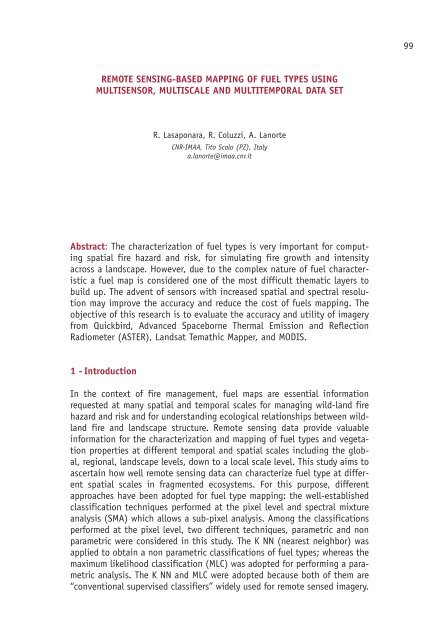7th Workshop on Forest Fire Management - EARSeL, European ...
7th Workshop on Forest Fire Management - EARSeL, European ...
7th Workshop on Forest Fire Management - EARSeL, European ...
Create successful ePaper yourself
Turn your PDF publications into a flip-book with our unique Google optimized e-Paper software.
REMOTE SENSING-BASED MAPPING OF FUEL TYPES USING<br />
MULTISENSOR, MULTISCALE AND MULTITEMPORAL DATA SET<br />
Abstract: The characterizati<strong>on</strong> of fuel types is very important for computing<br />
spatial fire hazard and risk, for simulating fire growth and intensity<br />
across a landscape. However, due to the complex nature of fuel characteristic<br />
a fuel map is c<strong>on</strong>sidered <strong>on</strong>e of the most difficult thematic layers to<br />
build up. The advent of sensors with increased spatial and spectral resoluti<strong>on</strong><br />
may improve the accuracy and reduce the cost of fuels mapping. The<br />
objective of this research is to evaluate the accuracy and utility of imagery<br />
from Quickbird, Advanced Spaceborne Thermal Emissi<strong>on</strong> and Reflecti<strong>on</strong><br />
Radiometer (ASTER), Landsat Temathic Mapper, and MODIS.<br />
1 - Introducti<strong>on</strong><br />
R. Lasap<strong>on</strong>ara, R. Coluzzi, A. Lanorte<br />
CNR-IMAA, Tito Scalo (PZ), Italy<br />
a.lanorte@imaa.cnr.it<br />
In the c<strong>on</strong>text of fire management, fuel maps are essential informati<strong>on</strong><br />
requested at many spatial and temporal scales for managing wild-land fire<br />
hazard and risk and for understanding ecological relati<strong>on</strong>ships between wildland<br />
fire and landscape structure. Remote sensing data provide valuable<br />
informati<strong>on</strong> for the characterizati<strong>on</strong> and mapping of fuel types and vegetati<strong>on</strong><br />
properties at different temporal and spatial scales including the global,<br />
regi<strong>on</strong>al, landscape levels, down to a local scale level. This study aims to<br />
ascertain how well remote sensing data can characterize fuel type at different<br />
spatial scales in fragmented ecosystems. For this purpose, different<br />
approaches have been adopted for fuel type mapping: the well-established<br />
classificati<strong>on</strong> techniques performed at the pixel level and spectral mixture<br />
analysis (SMA) which allows a sub-pixel analysis. Am<strong>on</strong>g the classificati<strong>on</strong>s<br />
performed at the pixel level, two different techniques, parametric and n<strong>on</strong><br />
parametric were c<strong>on</strong>sidered in this study. The K NN (nearest neighbor) was<br />
applied to obtain a n<strong>on</strong> parametric classificati<strong>on</strong>s of fuel types; whereas the<br />
maximum likelihood classificati<strong>on</strong> (MLC) was adopted for performing a parametric<br />
analysis. The K NN and MLC were adopted because both of them are<br />
“c<strong>on</strong>venti<strong>on</strong>al supervised classifiers” widely used for remote sensed imagery.<br />
99
















